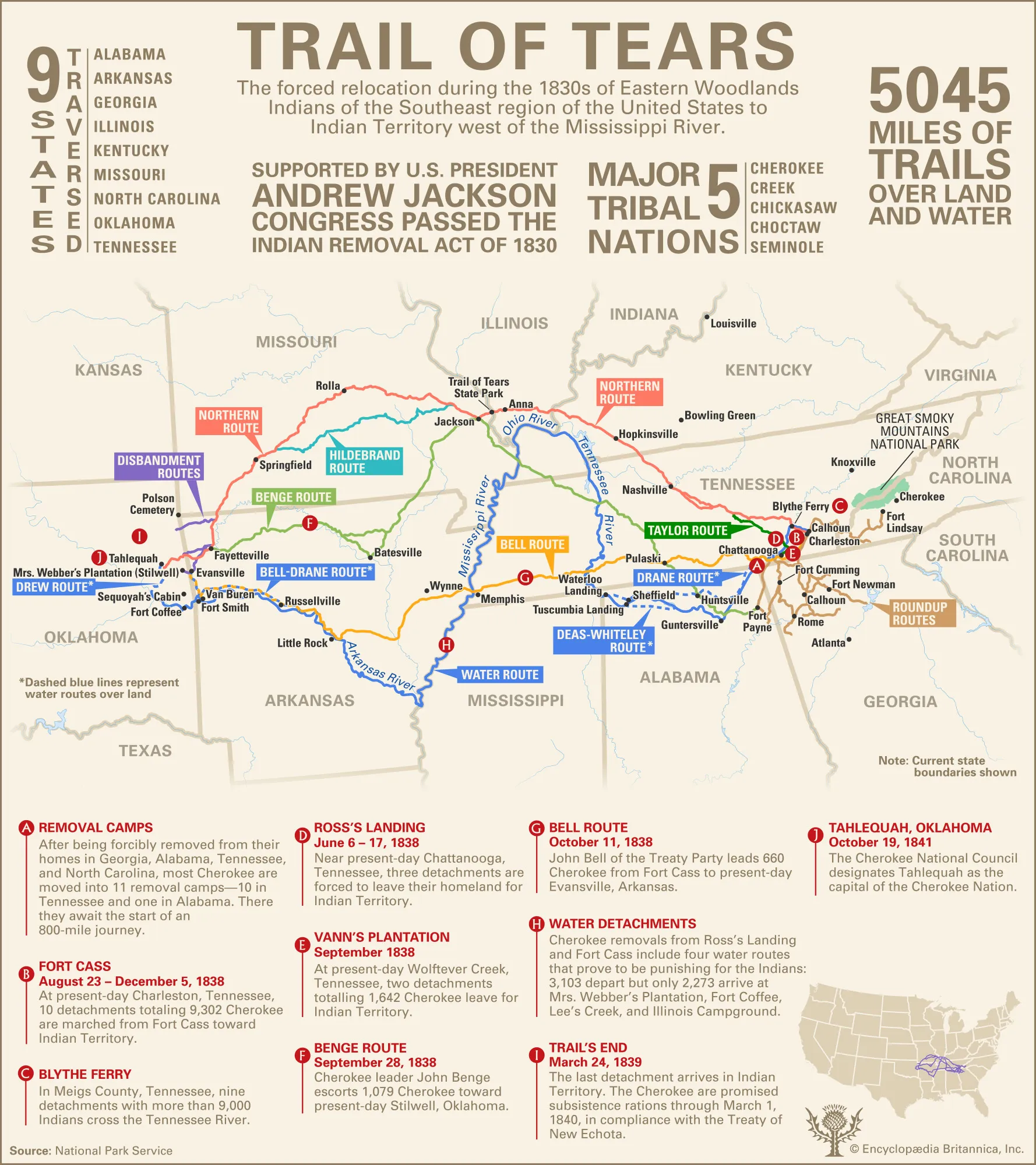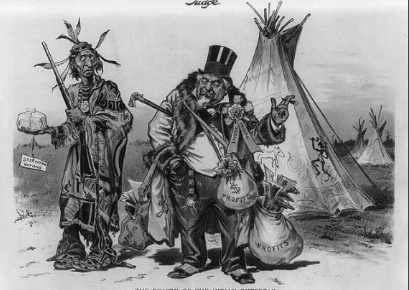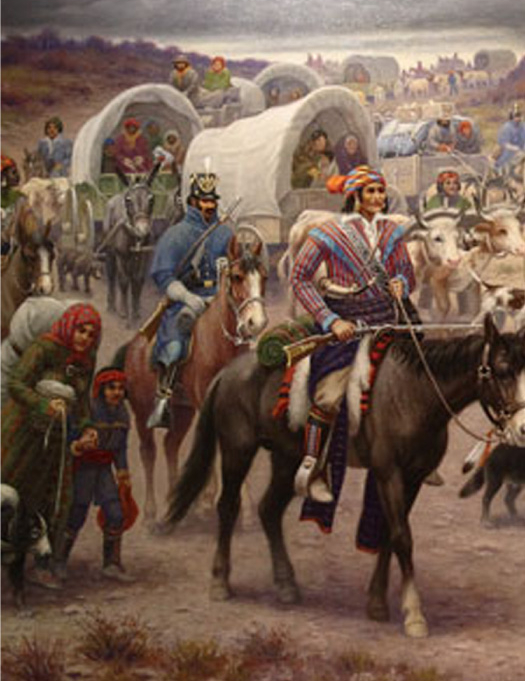
A map of the Trail of Tears. Source: Britannica
The Indian Removal Act of 1830 had two primary effects on the early White Americans. One being that it had a quick and lasting impact on the demographics of the nation. The Native Americans were being removed and thus were becoming less of an obstacle for the growth of a nation.
"In 1830 it was endorsed, when Congress passed the Indian Removal Act to force those remaining to move west of the Mississippi. Between 1830 and 1850, about 100,000 American Indians living between Michigan, Louisiana, and Florida moved west after the U.S. government coerced treaties or used the U.S. Army against those resisting. Many were treated brutally. An estimated 3,500 Creeks died in Alabama and on their westward journey. Some were transported in chains." (National Parks)
“With the exception of a small number of Seminoles still resisting removal in Florida, by the 1840s, from the Atlantic to the Mississippi, no Indian tribes resided in the American South. Through a combination of coerced treaties and the contravention of treaties and judicial determination, the United States Government succeeded in paving the way for the westward expansion and the incorporation of new territories as part of the United States”. (Office of the Historian)
¨Native Americans relocated west, opening 25 million acres of land to white settlement and to slavery." (PBS)
The second effect is that it brought the southern states and the federal government together.
On the other hand, the early effect of the Indian Removal Act directly led to the horrendous Trail of Tears that killed thousands of Native Americans during the forced removal.

A map of the Trail of Tears. Source: Britannica
"Trail of Tears, Forced migration in the United States of the Northeast and Southeast Indians during the 1830s. The discovery of gold on Cherokee land in Georgia (1828–29) catalyzed political efforts to divest all Indians east of the Mississippi River of their property. The Indian Removal Act (1830) authorized the U.S. president to negotiate with tribes for land cessions and removal to western territories. Many native people were forced from their homes, and most undertook the westward journey under severe duress. Some 15,000 died of exposure and disease on the journey, which became known as the Trail of Tears. Although the Trail of Tears is most closely associated with the Cherokee specifically and the Southeast tribes more generally, perhaps one-third to one-half of the 100,000 people removed were Northeast Indians." (Britannica)
"They marched, poorly equipped, alongside caravans of wagons, for more than four months, through blizzards and bitter winter weather. Their varying routes covered 1,609 kilometers (1,000 miles) or so, traversing parts of Tennessee, Kentucky, Illinois, Missouri, and Arkansas. Others traveled over water along the Tennessee, Ohio, Mississippi, and Arkansas rivers, until they reached the eastern edge of present-day Oklahoma. At every stop along the trail, funerals and burials were held. The death toll from the internment camps, the migration, and its aftermath topped 4,000, out of a population of more than 16,000. They died of exposure to the elements, malnutrition, various diseases, and sheer physical exhaustion"(National Geographic Society).
"Their travels were marked by outbreaks of cholera, inadequate supplies, bitter cold, and death from starvation and exhaustion. The Cherokees' march was a forced one under the direction of the United States army, and it came to be known as the "Trail of Tears" or, in their own term, "The Place Where They Cried." Removal was a tragedy as thousands of people were forced to leave behind their homes, livestock, crops, and places that had spiritual significance for them." (National Humanities Center)
"By March 1839, all survivors had arrived in the west. No one knows how many died throughout the ordeal, but the trip was especially hard on infants, children, and the elderly. Missionary doctor Elizur Butler, who accompanied the Cherokees, estimated that over 4,000 died- nearly a fifth of the Cherokee population" (National Parks Service) .
One survivor told how his father got sick and died; then, his mother; then, one by one, his five brothers and sisters. "One each day. Then all are gone." Another survivor recalled:
"Long time we travel on way to new land. People feel bad when they leave Old Nation. Womens cry and make sad wails. Children cry and many men cry...but they say nothing and just put heads down and keep on go towards West. Many days pass and people die very much." (National Parks Service)
"Within the first few years of arrival west, the resettled American Indian population was decimated by cholera, malaria, smallpox, and influenza. “We did not visit a house, wigwam, or camp,” wrote a distressed missionary, “where we did not find more or less sickness, and in most instances the whole family were prostrated by disease. Great numbers of them have died.” The sickness hit the children hardest, and child death rates soared."(Bill of Rights Institute)

A political cartoon of a Indian holding a musket and package labeled "starvation rations." Standing next to an Indian agent carrying bags of money. Source ExplorePAHistory.com
“The legacy of the Trail of Tears is one of death and misery that has left a stain on this period of American history. ” (HistoryinCharts)

A image of the relocation of Native Americans. Source: Bill of Rights Institute
"At their peak, the Cherokee controlled land in the present-day states of Georgia, Alabama, Tennessee, and North Carolina. By the end of the 1830s, most Cherokee had either relocated voluntarily or were forced to move to Indian Territory, as shown in a modern artist’s rendition of the Cherokee relocation journey on The Trail of Tears." (Bill of Rights Institute)